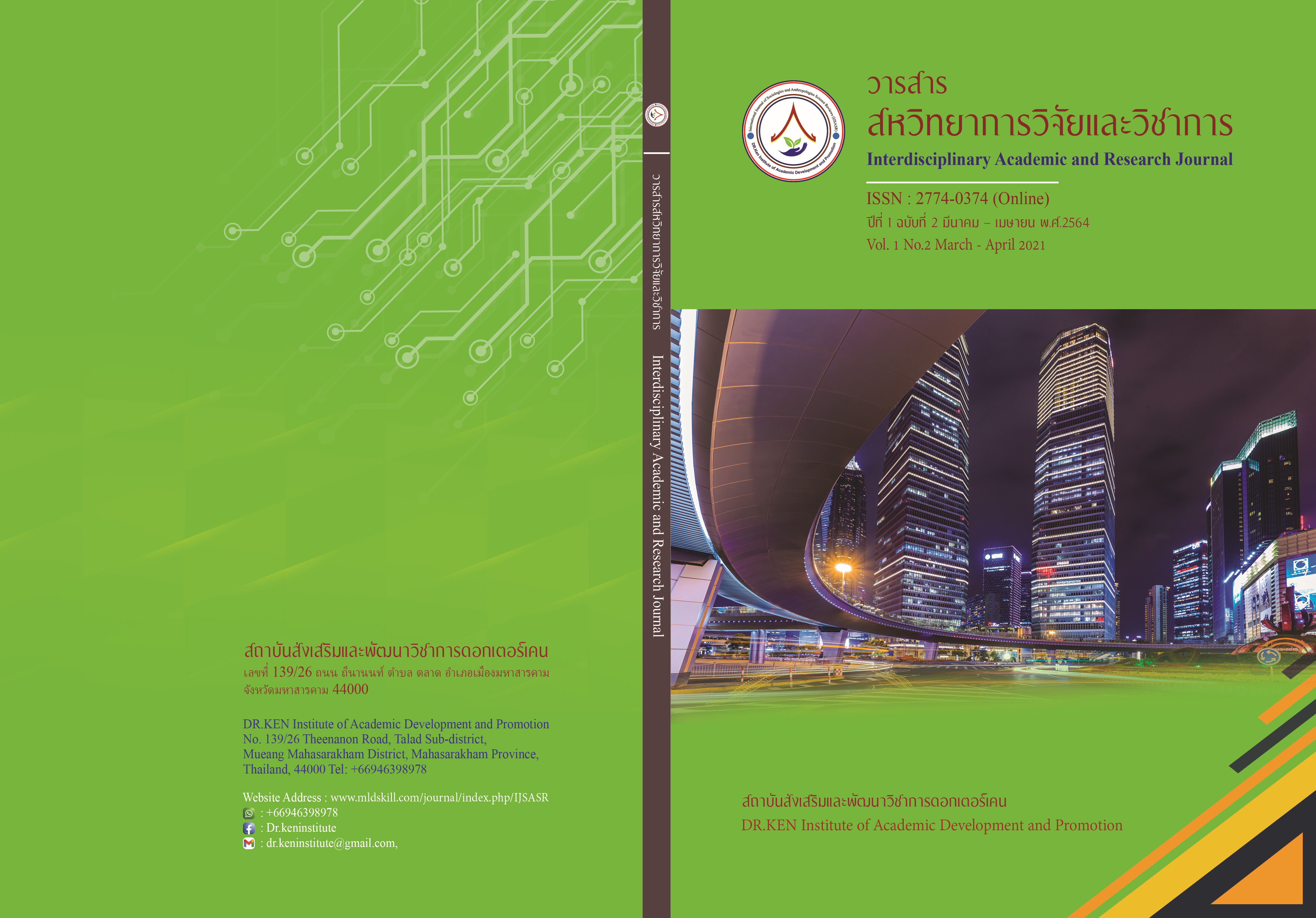The behavior of Chemical Use in Ban Non-Sawang Community, Sao Lao Subdistrict, Nong Kung Si District, Kalasin Province
DOI:
https://doi.org/10.14456/iarj.2021.8Keywords:
Chemical Use Behavior, Wisdom and Technology, Innovation ProcessAbstract
The chemical toxicity that has been going on in the community has been a problem that has been going on for many years and has turned into a serious impact. This is because the community has a large proportion of agricultural occupations and occupations that are at risk of adverse health effects. The purpose of this research was to study the situation and behavioral problems in chemical use in Ban Non-Sawang, Tam Sao Lao, Am Nong Kung Si, Kalasin Province. The target groups are defined in a specific way, including academics, village philosophers, community leaders, community representatives, teachers, people, and farmers, totaling 50 people. The tools for collecting the data were both quantitative and qualitative, using opinion polls from community forums, participant observation. (Participative Observation), interview (Interview), Focus Group. The research results found that.
1. The study of the process of information potential, the body of knowledge, wisdom, and appropriate chemical use technology in the community found that it was divided into 3 eras, namely, the era of farming, the era of farming and oil, cassava, and the era of sugarcane and cassava plantations.
2. Adopting an innovative process that has appropriate results in driving various activities in Ban Non-Sawang community as a model for other communities, divided into 4 issues as follows: Seeking, saving, spending, and connecting with other areas of life.
References
กฤติญา แสงภักดี และคณะ. (2557). การศึกษาพฤติกรรมการใช้สารเคมีในการกําจัดศัตรูพืชของชาวนา อําเภอองครักษ์ จังหวัดนครนายก. แก่นเกษตร, 42 (3), 375-384.
ชัชชัย ธนโชคสว่าง และคณะ. (2563). สื่อส่งเสริมความปลอดภัยเพื่อการใช้สารเคมีกําจัดศัตรูพืชในกลุ่มเกษตรกรและกลุ่มยุวเกษตรกรจังหวัดกาญจนบุรี. วารสารความปลอดภัยและสุขภาพ. 13 (2), 107-119.
ดวงใจ วิชัย, ปัตพงษ์ เกษสมบูรณ์ และ ณัฐปคัลภ์ สันวิจิตร. (2561). “พฤติกรรมเสี่ยงและปัจจัยที่มีความสัมพันธ์กับความเสี่ยงในการใช้สารเคมี กำจัดศัตรูพืชของเกษตรกร ในพื้นที่ต้นน้ำเขื่อนลำปะทาว จังหวัดชัยภูม”. สำนักงานป้องกันควบคุมโรคที่ 7 ขอนแก่น, 25 (2), 22-34.
น้ำเงิน จันทรมณี.(2560). พฤติกรรมการใช้สารกําจัดศัตรูพืชและประสิทธิผลของการให้อาชีวสุขศึกษาที่มีผลต่อความรู้ทางด้านความปลอดภัยของเกษตรกรพื้นที่ต้นน้ำ จังหวัดพะเยา. วารสารความปลอดภัยและสุขภาพ, 37, 35-45.
วิภาดากระตุดนาค, สายัณต์แก้วบุญเรือง, บุญร่วมแก้วบุญเรือง. (2562). ปัจจัยที่มีความสัมพันธ์กับพฤติกรรมในการป้องกันอันตรายจากการใช้สารเคมีกำจัดศัตรูพืชของเกษตรกรบ้านหนองหัววัว ตำบลโคกสี อำเภอเมือง จังหวัดขอนแก่น. วารสารวิทยาศาสตร์สุขภาพและการสาธารณสุขชุมชน, 2 (2), 96-105.
Goontalee Bangkadanara, Chatchai Thanachoksawang, & Sara Arphorn. (2017). Self-Evaluation for Work Improvement among Vermicomposting Disabled-Farmers, Journal of Safety and Health, 10 (35), 1-9.
Downloads
Published
How to Cite
Issue
Section
License
Copyright (c) 2021 Interdisciplinary Academic and Research Journal ISSN 2774-0373 (Online)

This work is licensed under a Creative Commons Attribution-NonCommercial-NoDerivatives 4.0 International License.
Copyright on any article in the Interdisciplinary Academic and Research Journal is retained by the author(s) under the under the Creative Commons Attribution-NonCommercial-NoDerivatives 4.0 International License. Permission to use text, content, images, etc. of publication. Any user to read, download, copy, distribute, print, search, or link to the full texts of articles, crawl them for indexing, pass them as data to software, or use them for any other lawful purpose. But do not use it for commercial use or with the intent to benefit any business.
















.png)


